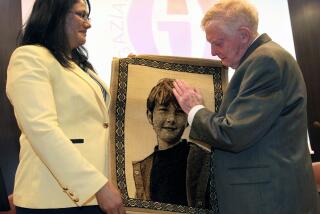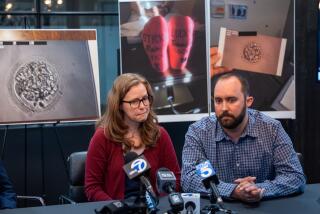Frank Admissions End Infant Organ Harvesting
Conceding that their plans to harvest organs from brain-defective babies have “failed dismally” and that the ethical qualms of critics have often proven true, Loma Linda University Medical Center officials have suspended the controversial program to use anencephalic infants as organ donors.
The decision, reached late last month but never publicized, follows 13 failed attempts at organ harvesting from the babies.
“We have no plans in the immediate future . . . of continuing to enter infants” into the program, Dr. Joyce L. Peabody, Loma Linda’s chief of neonatology, said in a telephone interview Thursday. “I have become educated by the experience.”
Leading bioethicists say that a broad national consensus is now required before other medical centers launch similar experiments.
While anencephalics have been used as organ donors in Holland, West Germany and Japan, Loma Linda has the only such program in the United States.
Caring for the severely deformed infants has been “incredibly difficult” for intensive-care unit nurses, as well as some physicians, according to Peabody, who is in charge of the program. Only one-third to one-half of the nurses volunteered to care for the babies.
In one case, Peabody said, a baby who appeared to be a suitable candidate for organ donation had to be withdrawn after a physician “started to cry and became very uncomfortable with the experience.”
Anencephalics are born missing parts of the brain and skull. They usually die at birth or within several days. Loma Linda physicians had hoped that the babies could be declared brain dead while their heart, liver and other organs remained undamaged and suitable for transplantation.
Some ethicists and physicians have contended that placing anencephalic newborns on life support crosses into uncharted territory by prolonging life not for the benefit of the patient but for the sole purpose of harvesting organs.
At a bioethics seminar in Oakland last week, Peabody acknowledged that she had “spent many an hour with friends in the mountains discussing that and we have not come to a clear understanding of it.”
Peabody also said that she was increasingly troubled by the implications of Loma Linda’s widely publicized “protocol” for anencephalics, including concerns that it represented a misuse of “limited” health care resources and that it was “compromising the dignity” of the deformed children. Peabody was the principal author of the protocol, which details the medical, legal and ethical guidelines for trying to obtain organs from the babies.
One of the first babies, who had been expected to die within days of birth, remained alive for two months. “That scared me to death,” Peabody said. “I was very worried that she might be one of these ‘Ripley’s Believe-It-or-Not’ anencephalic infants who lives for a year and that somehow I would feel responsible that maybe the protocol precipitated that.”
A tape recording of Peabody’s Aug. 10 talk--at a session that was open to the media--was made available to The Times by Kaiser Permanente, the sponsor of the seminar.
Anita Rockwell, a Loma Linda spokeswoman, said that the medical center will honor commitments to attempt organ harvesting in two as-yet unborn anencephalic infants. The program’s long-term future is in limbo, pending completion of a report that Peabody is preparing for a medical journal.
Peabody’s remarks represent the most candid assessment to date of the pitfalls of salvaging organs from anencephalics, a possibility that is also under discussion at the UC Medical Center in San Francisco and other transplantation centers across the country.
“It takes a particular amount of courage to acknowledge that you may have made a mistake,” said Leslie Rothenberg, a UCLA Medical Center faculty member who specializes in medical ethics. “I am positively impressed by (Dr. Peabody’s) willingness to state this openly.” Rothenberg has been a critic of the Loma Linda program.
Arthur Caplan, director of the Center for Biomedical Ethics at the University of Minnesota in Minneapolis, said that Loma Linda’s physicians had become “confused” and “weren’t able to competently manage the dying of these infants.” Caplan, a strong advocate of expanded use of anencephalic organ donors, said the medical center had also encountered “a lot of criticism for trying to pioneer a new view for determination of death without getting consensus from their peers in medicine.”
Validity of Concerns
At the bioethics symposium, Peabody also acknowledged the validity of concerns that some physicians would now attempt to harvest organs from infants with less-severe birth defects, such as babies born with an abnormal amount of fluid around the brain or those born without kidneys but with a normal brain. Peabody said that “good” physicians had tried to refer several such cases and “couldn’t understand the difference” between such newborns and anencephalics. “I have grown up in the last nine months,” she said. “The slippery slope is real.”
Peabody said she did not consider the overall effort to be a “failure” because important medical knowledge has been gained and because “all of the parents” of the prospective organ donors have been “very satisfied with the experience.”
She said in an interview that Loma Linda will continue other efforts to make more organs available for the “40% to 70% of infants who die while waiting for organs.”
‘Failed Dismally’
But she added: “Certainly, if the only outcome you are looking at is the number of solid organs transplanted, our program has failed, and failed dismally.”
The program started last December, two months after Loma Linda’s Dr. Leonard Bailey transplanted a heart from an anencephalic infant, who had been declared brain dead in Canada and then transported to Loma Linda, into Paul Holc, another Canadian infant. Paul, who was born with a fatal heart defect, is now home with his parents in Vancouver.
Of the first seven cases, one baby was stillborn and five did not meet brain-death criteria within seven days of birth, a time limit set by Loma Linda on how long the newborn would be eligible to be considered as organ donors.
‘Experience in Frustration’
No recipient could be found for the organs of the single baby that was declared brain dead, despite the preliminary identification of suitable recipients at three medical centers. “Baby John was an experience in frustration,” Peabody said. “One university turned us down even through the baby was confirmed brain dead because they didn’t want to get involved with the media.”
In April, medical center physicians decided to change their practice of placing the babies on respirators as soon as they were born. Instead, they decided to wait until the infants experienced breathing or circulatory difficulties before employing artificial life-support systems. “Supporting the baby artificially from birth may delay the natural dying process and interrupt the development of brain death,” Peabody said in an interview at the time.
‘Imminent Death’
Five of the next six babies reached “imminent death” within a week of birth, but four could not be used as donors. In three of the cases, the babies were not brain dead after they were finally placed on respirators and remained alive beyond the seven-day limit. In another case, the baby’s heart and lungs could not be resuscitated. Peabody concluded that it was still “not possible to maintain organ viability” while “allowing the natural dying process to proceed.”
One child, Baby Aaron, appeared to be a suitable organ donor--until a crisis developed among his physicians. “One of my neonatologists started to cry and became very uncomfortable with the experience,” Peabody said. “We had said at the outset if any key health care provider felt uncomfortable, we would stop.”
Peabody explained: “This is a 180-degree turn for all of us involved from what we normally do in the intensive-care nursery. Usually, the patient we are caring for . . . is a patient that we honestly hope will someday be a 5-year-old riding a bike.”
‘Seemed a Bit Distorted’
Loma Linda’s neonatal intensive-care nursery may have as many as 76 newborns at any time. “To suddenly have the director involved with talking with Oprah Winfrey shows and Channel 2 all the time was very, very difficult and seemed a bit distorted,” the neonatologist said.
Peabody also discussed the need for the medical center to consider not only if its decisions were “right and best for the patient” but also “how will it look?” As an example, she cited the case of Baby Hope, the newborn who remained alive for two months.
When Baby Hope’s parents wanted to bring her back to Tennessee to die, Peabody became alarmed by their plans to take a “regular commercial Delta flight that made two stops.” She said: “They could not understand why I felt it was much better to fly the baby back in a Lear jet. You can imagine having an anencephalic infant die in the air with businessmen needing to get places. It could have caused us a lot of controversy and would have made us look bad, very bad at best.”
More to Read
Sign up for Essential California
The most important California stories and recommendations in your inbox every morning.
You may occasionally receive promotional content from the Los Angeles Times.










